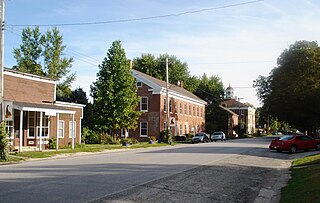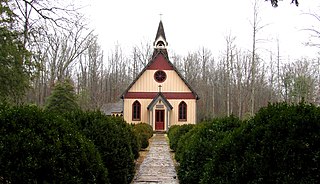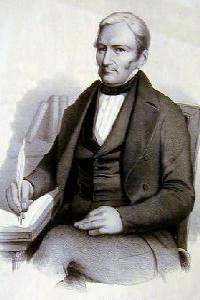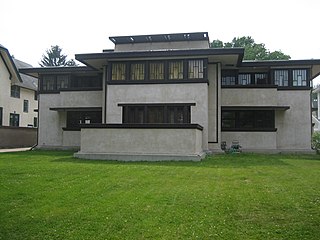
Bishop Hill is a village in Henry County, Illinois, United States, along the South Edwards River. The population was 128 at the 2010 census, up from 125 in 2000. It is the home of the Bishop Hill State Historic Site, a park operated by the Illinois Historic Preservation Agency.

Cambridge is a village and the county seat of Henry County, Illinois, United States. The population was 2,160 at the 2010 census, down from 2,180 in 2000.

Rugby is an unincorporated community in Morgan and Scott counties in the U.S. state of Tennessee. Founded in 1880 by English author Thomas Hughes, Rugby was built as an experimental utopian colony. While Hughes's experiment largely failed, a small community lingered at Rugby throughout the 20th century. In the 1960s, residents, friends and descendants of Rugby began restoring the original design and layout of the community, preserving surviving structures and reconstructing others. Rugby's Victorian architecture and picturesque setting have since made it a popular tourist attraction. In 1972, Rugby's historic area was listed under the name Rugby Colony on the National Register of Historic Places as a historic district.

The Icarians were a French-based utopian socialist movement, established by the followers of politician, journalist, and author Étienne Cabet. In an attempt to put his economic and social theories into practice, Cabet led his followers to the United States of America in 1848, where the Icarians established a series of egalitarian communes in the states of Texas, Illinois, Iowa, Missouri, and California. The movement split several times due to factional disagreements.

Étienne Cabet was a French philosopher and utopian socialist who founded the Icarian movement. Cabet became the most popular socialist advocate of his day, with a special appeal to artisans who were being undercut by factories. Cabet published Voyage en Icarie in French in 1839, in which he proposed replacing capitalist production with workers' cooperatives. Recurrent problems with French officials, led him to emigrate to the United States in 1848. Cabet founded utopian communities in Texas and Illinois, but was again undercut, this time by recurring feuds with his followers.

Swedish Americans are Americans of Swedish ancestry. They include the 1.2 million Swedish immigrants during 1865–1915, who formed tight-knit communities, as well as their descendants and more recent immigrants.

William Keil was the founder of 19th-century communal religious societies in Bethel, Missouri, and Aurora Colony in Oregon.

Bishop Hill State Historic Site is an open-air museum in Henry County, Illinois. It is located about 2 miles north of U.S. Route 34 in Bishop Hill, Illinois.
Eric or Erik Jansson or Janson was the leader of a Swedish Radical Pietist sect that emigrated to the United States in 1846.

The Frank Lloyd Wright/Prairie School of Architecture Historic District is a residential neighborhood in the Cook County, Illinois village of Oak Park, United States. The Frank Lloyd Wright Historic District is both a federally designated historic district listed on the U.S. National Register of Historic Places and a local historic district within the village of Oak Park. The districts have differing boundaries and contributing properties, over 20 of which were designed by Frank Lloyd Wright, widely regarded as the greatest American architect.

Kennicott Grove is an area of prairie and wooded lands that includes the home of John Kennicott (1802–1863) and his family, including his son Robert Kennicott (1835–1866). John Kennicott was an agriculturalist and a doctor. Robert Kennicott was a naturalist and an explorer, who founded the Chicago Academy of Sciences. The grove is 123 acres (0.50 km2) in size. It is located near the intersection of Milwaukee Ave. and Lake Ave. in Glenview, Illinois, in the United States. Kennicott Grove was declared a National Historic Landmark in 1976. The site is maintained by the Glenview Park District as The Grove National Historic Landmark or also The Grove, and contains a nature interpretive center, historic buildings, and nature trails.

The F. F. Tomek House, also known as The Ship House or as the Ferdinand Frederick and Emily Tomek House, is a historic house in Riverside, Illinois. It is prominent example of Prairie School design by Frank Lloyd Wright. Designed in 1904 and construction finished in 1906, the Tomek House is a well-preserved example of the style. In addition to being a good example of the Prairie style, the Tomek house documents the development of the style, which reached its clearest expression in Wright's Robie House in 1908. It is included in the Riverside Historic District and was declared a National Historic Landmark in 1999.

The Cushnoc Archeological Site, also known as Cushnoc or Koussinoc or Coussinoc, is an archaeological site in Augusta, Maine that was the location of a 17th-century trading post operated by English colonists from Plymouth Colony in present-day Massachusetts. The trading post was built in 1628 and lies on the Kennebec River. The English primarily traded with bands of the Abenaki nation.

Olof Krans was a Swedish-American folk artist. A self-taught artist, he painted in a style referred to as primitive or Naïve art.
The Clarendon Hills Historical Society is a volunteer-run organization in Clarendon Hills, Illinois tasked with retaining the town's history and establishing a community center for town residents to use as a gather place, as well as a museum to display prominent artifacts pertaining to the history of the village.

The Jenny Lind Chapel is a historic church located at the southwest corner of 6th and Oak Streets in Andover, Illinois. Completed in 1851 for a congregation founded the previous year, the church was the first built by the Augustana Synod, the main Swedish Lutheran church in America. Pastor Lars Paul Ebsjorn founded the church for local Swedes who still wished to worship with the Church of Sweden; many were former members of the nearby Bishop Hill Colony who had lost faith in Eric Jansson's teachings, while the others were Swedes who had immigrated to the area due to the colony's fame. The church was named in honor of Swedish opera singer Jenny Lind, who donated $1,500 for its construction. The building has a simple design with Greek Revival features, a common form for small rural churches of the era.

The Olof Johnson House is a historic house located at 408 NW 4th Street in Galva, Illinois. The house was built in 1863 for Olof Johnson, one of the trustees of the Bishop Hill Colony. In addition to his position within the colony, Johnson also played a significant role in Galva's founding and named the community after his birthplace of Gävle, Sweden. Johnson's house has an Italianate design, a popular style in the late 19th century. The house's wraparound front porch is supported by thin columns and features paired brackets along its roof; similar brackets can be found on the eaves of the house's cross gabled roof.

Eric Bergland was a Swedish-born American military officer. The son of religious refugees that brought him from Sweden to the United States, he fought in the American Civil War as a volunteer officer, graduated from West Point at the top of his class, served his adopted country with distinction as an officer of the regular army, a professor of his Alma Mater, and a Western explorer, and married a cousin of the wife of president Rutherford B. Hayes.

Olof Gustaf Hedstrom was a Swedish-American minister who oversaw the Bethel Ship mission serving sailors and immigrants arriving in New York City from 1845-1876. Hedstrom's ministry influenced Swedish settlement patterns in the United States and established the earliest Swedish Methodist congregations in New York, Pennsylvania and Illinois. Hedstrom trained a ministerium of Scandinavian pastors aboard the Bethel Ship mission who went on to lead parishes and missions throughout the United States as well as establishing the Methodist church in Scandinavia.

























